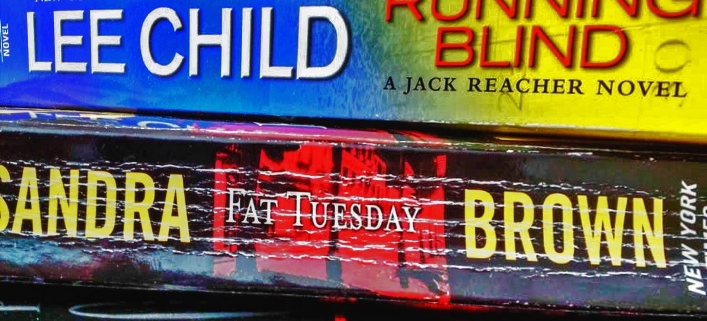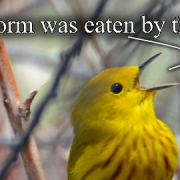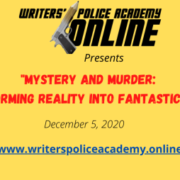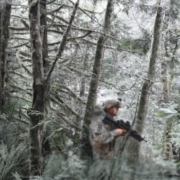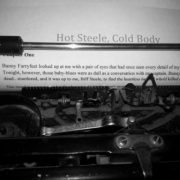He Angrily and Loudly, and a Bit Threateningly, said, “Stop Using So Many “LY” Words!
Does your latest tall tale feature a beginning, middle, and end? How about characters, setting, and dialog? Have you been especially creative by inserting lots of sentences composed of various words with various meanings? Do you know the difference between a police chief and a sheriff? Are you aware that the FBI does not typically investigate local murder cases, that it is the duty of local police to solve those crimes?
If you answered yes to each of the above questions, well, you’ve taken a few of the appropriate first steps toward accurately writing about cops, crime, and crooks.
So, you conduct tons of research by visiting online websites and by participating in your local citizen’s police academy, and those are fantastic resources. But have you considered going the extra mile by spending a bit of extra research time to develop ways to activate the senses of your readers? After all, using the senses is a huge key to the success of showing, not telling. And the use of the senses creates an important emotional connection between the story and the reader.
How does a writer create scenes that ignite a reader’s senses of touch, taste, hearing, smell, and sight? Well, for starters, they should call on past life experiences and then translate those experiences into dynamic descriptive words and phrases. However, when describing mood, setting, to emphasize a point in dialogue, etc., writers should avoid using an abundance of clunky “ly” words.
Words ending in “ly” are often clunky and clumsy
Words ending in “ly” are often redundant and quite frankly, unnecessary. They can slow the reader and are often so jarring they could stop the flow of the story. Is it possible to draw on personal experiences and then to write those powerful scenes without the use of “ly” words? Well, let’s check in with a few top storytellers.
For example …
Patricia Cornwall didn’t invent rain, leaves, or playing fields, but she obviously drew on her memories to create the passage below. It’s a simple scene, but it’s a scene I can easily picture in my mind as I read. I hear the rain and I feel the cool dampness of the asphalt, grass, and tile roof. The writing also conjures up images of raindrops slaloming down windowpanes, and rushing water sweeping the streets clean of debris. The splashing and buzzing sound of car tires pushing across water-covered roadways. And she accomplished the imagery without using a single “ly” word.
“It was raining in Richmond on Friday, June 6. The relentless downpour, which began at dawn, beat the lilies to naked stalks, and blacktop and sidewalks were littered with leaves. There were small rivers in the streets, and newborn ponds on playing fields and lawns. I went to sleep to the sound of water drumming on the slate roof…” ~ Patricia Cornwell, Post Mortem.
Sandra Brown takes us on brief “no “ly word” journey through a pasture on a hot day. We know it’s hot because of the insect activity. We also know the heat of the day increases the intensity of the odor of horse manure. And, Brown effectively makes us all want to help Jack watch where he steps.
“Jack crossed the yard and went through a gate, then walked past a large barn and a corral where several horses were eating hay from a trough and whisking flies with their tails. Beyond the corral he opened the gate into a pasture, where he kept on the lookout for cow chips as he moved through the grass.” ~ Sandra Brown, Unspeakable.
Here’s a decent rule of thumb – Write the scene and then remove all unnecessary flowery words, especially those that end in “ly.”
Too many “ly” words are often difficult for readers to take in. Besides, they can slow the story and do nothing to further it.
Lee Child is a master when it comes to describing a scene with few words. Here’s a fun exercise. Count the number of times Child uses an “ly” word in the text below. Then consider whether or not you would have used unnecessary “ly” words had you written this scene? Aha! Perhaps it’s time to step away from using clunky words.
“The bar was a token affair built across the corner of the room. It made a neat sharp triangle about seven or eight feet on a side. It was not really a bar in the sense that anybody was going to sit there and drink anything. It was just a focal point. It was somewhere to keep the liquor bottles. They were crowded three-deep on glass shelves in front of sandblasted mirrors. The register and credit card machine were on the bottom shelf.” ~ Lee Child, Running Blind.
Another example of effectively and masterfully projecting an image into a reader’s mind comes from James Lee Burke. Short. Sweet. And tremendously effective.
“Ida wore a pink skirt and a white blouse with lace on the collar; her arms and the top of her chest were powdered with strawberry freckles.” ~ James Lee Burke, Crusader’s Cross.
Okay, what does all of this have to do with writing about cops, you ask? Well, in the passages above, the authors created a micro world by using a few, but extremely powerful and carefully chosen words. And it’s obvious to the reader that each of the writers called upon their own experiences to write those scenes. They’ve been there and done that, and their imaginations have conjured up memories of things they’ve seen, touched, tasted, heard, and smelled. And all without the use of words ending in “ly.” Just simple, clunk-free writing.
Cops live and work in a unique world that’s generally not accessible to the average person, including writers. They experience things that most only read about or see on TV news reports. And that brings us full circle. How can a writer effectively write, and activate a reader’s senses, about something they’ve only read about or heard second and third hand from someone reading to them, word-for-word from a teleprompter?
I think Joseph Wambaugh, one of the best cop-writers of our time, offers a brilliant guideline to follow when writing cops. Wambaugh said, “The best crime stories are not about how cops work on cases. They’re about how cases work on cops.”
Paste Wambaugh’s quote near your computer. Glance it as you write. Keep it in mind while developing law enforcement characters and scenes.
To increase your knowledge of forensics and writing, I strongly urge you to attend courses and classes offered by Writers’ Police Academy Online. These sessions take participants behind the scenes to places typically visited only by law enforcement. The value of information provided is immeasurable, especially so for writers whose goal is to deliver top shelf material.
As a bonus, USA Today & Wall Street Journal bestselling author Lisa Regan details how to use the elements of fiction to craft a gripping crime novel.
Sign up today to reserve your seat!

